Mixing styles
Labels: Belle, Sovanna Phum, Yon Chantra
Cambodia - Temples, Books, Films and ruminations...
Labels: Belle, Sovanna Phum, Yon Chantra
 Not sure why or how, but a new dance performance coming up this weekend, had managed to elude me until today. Especially as it includes my favourite Cambodian dancer, Belle (right), and some of the great young dancing talent the country is blessed with. Movin' is a contemporary meets classical piece that will be hosted by Sovanna Phum this coming Saturday and Sunday at 7.30pm. Tickets for barang cost $6, $2 for Khmers. With choreography by Yon Davy and the dancers themselves, under the direction of Bob Ruijzendaal, it's another step forward in the cycle of new works by the group known as New Cambodian Artists. Find out more here. Belle performed in the Hong Kong Arts Festival earlier this month with Emmanuèle Phuon's piece, Khmeropedies II and will be in Singapore in late May. Then it's off to the United States in June to perform Khmeropedies I and II in New Haven and at the Baryshnikov Arts Centre in New York, and back to Singapore in August. Joining Belle on stage for the Khmeropedies performance will be the absolute cream of Cambodia's dancers: Sam Sathya, Chey Chankethya and Phon Sopheap.
Not sure why or how, but a new dance performance coming up this weekend, had managed to elude me until today. Especially as it includes my favourite Cambodian dancer, Belle (right), and some of the great young dancing talent the country is blessed with. Movin' is a contemporary meets classical piece that will be hosted by Sovanna Phum this coming Saturday and Sunday at 7.30pm. Tickets for barang cost $6, $2 for Khmers. With choreography by Yon Davy and the dancers themselves, under the direction of Bob Ruijzendaal, it's another step forward in the cycle of new works by the group known as New Cambodian Artists. Find out more here. Belle performed in the Hong Kong Arts Festival earlier this month with Emmanuèle Phuon's piece, Khmeropedies II and will be in Singapore in late May. Then it's off to the United States in June to perform Khmeropedies I and II in New Haven and at the Baryshnikov Arts Centre in New York, and back to Singapore in August. Joining Belle on stage for the Khmeropedies performance will be the absolute cream of Cambodia's dancers: Sam Sathya, Chey Chankethya and Phon Sopheap.Labels: Belle, Cambodian Living Arts, Khmeropedies, Movin'
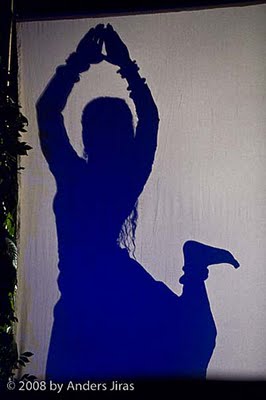 Okay, so what was supposed to be an occasional series has taken on a life of its own but 'friends' deserve their place in the limelight, although this particular friend of mine, Belle, or Chumvan Sodhachivy or Abelle, as she's variously known, needs no introduction to the spotlight. Her incredible penchant for dance, of all forms and styles, has propelled her to the fore of the new wave of contemporary dance in Cambodia and her star is definitely in the ascendancy. There's no stopping her. I love this picture of her, taken by Anders Jiras during a performance of modern Cambodian theater and the story of Preah Kongkea. My appreciation to Anders for some superb photos of Cambodian dance which you can enjoy here. As for Belle, she'll be off to Hong Kong, Singapore and the United States over the next few months, showcasing her undoubted talents to international audiences far and wide.
Okay, so what was supposed to be an occasional series has taken on a life of its own but 'friends' deserve their place in the limelight, although this particular friend of mine, Belle, or Chumvan Sodhachivy or Abelle, as she's variously known, needs no introduction to the spotlight. Her incredible penchant for dance, of all forms and styles, has propelled her to the fore of the new wave of contemporary dance in Cambodia and her star is definitely in the ascendancy. There's no stopping her. I love this picture of her, taken by Anders Jiras during a performance of modern Cambodian theater and the story of Preah Kongkea. My appreciation to Anders for some superb photos of Cambodian dance which you can enjoy here. As for Belle, she'll be off to Hong Kong, Singapore and the United States over the next few months, showcasing her undoubted talents to international audiences far and wide.Labels: Anders Jiras, Belle
Labels: Belle, Dansez Roam
Labels: Belle, Dansez Roam, Khmer Arts Ensemble
Labels: Belle, Dansez Roam, Yon Davy
Labels: Belle, Dansez Roam, Suites
Highly organised and efficient on one hand, Flying Circus also courts a creative openness that at times borders on chaos. The logic for Keng Sen is that the encounter must have its own energy, that the group itself must conjure something new from the situation. An approach like this takes time and nerve, but it undoubtedly pays off.
Looking back, it's hard to say what made the biggest impression on me. The country itself remains blighted by poverty, and still in recovery from the devastation of the Pol Pot era and subsequent years of civil war and instability. Culturally, there's a determined attempt to recover what the Khmer Rouge tried to wipe out in its brutal five-year drive to Year Zero, which involved – alongside much else – killing intellectuals, artists, teachers and anyone who spoke French. For this reason, there's much talk of archives, of remembering and preserving. Around 300 feature films were made in Cambodia before 1975, of which as few as 30 now survive. They have been gathered in the last five years and preserved along with other film, sound and photographic materials at the Bophana archive in Phnom Penh, our base for half of the workshops.
The situation is equally dire in the performing arts, since only a handful of classical Khmer dancers survived the killing fields. These old masters are now a precious resource, teaching new generations techniques that otherwise would have slipped away for good. Back home in England, I generally run a mile from people attempting to rescue traditional forms; but in Cambodia, the initiative made more sense – the difference, perhaps, between a past that is dying from irrelevance or lack of interest, and one that has only recently survived assassination.
What I sensed in the younger artists and dancers we worked with, though, was a desire to move forwards with the past, and not to retreat into it. These Cambodian twentysomethings are savvy and hungry, and well aware that their country is opening up, and that internationally financed redevelopment and tourism have been following the inflow of NGOs. They know that they'll need new approaches in the arts, and new political voices to meet the challenges ahead.
I asked Keng Sen what he feared the most from his project. We talked about economic and political dangers (artists as the vanguard for property developers) and about the cultural dangers (Cambodians caught in retreading western postmodern art practice). Then we talked about the positives: the meetings, the collisions, the insistence on and the articulation of differences. There was one moment in the workshops that crystallised these possibilities for me. Tarek Atoui, Lebanese sound artist, ran a session with the Khmer participants that involved sounds collected by the dancers played out from a laptop and a complex array of homemade sensors, motion triggers and pressure pads. It was late in the afternoon when the dancers from Amrita Performing Arts, our hosts for half of the project, took to their feet and began to move in and around Atoui's machinery.
What happened was tentative at first, then suddenly too much. It was as if the dancers wanted to play the system, or make music with it, rather than dance with it. My heart sank. Then all at once they turned a corner and were dancing again – the turning wrists and fingers, lowered centres of gravity, eye contact, pantomime pauses and forward rolls all instantly recognisable from Khmer classical forms. They weren't dancing for the electronics, nor were they dancing with them exactly; they were dancing with and against them, entering and refusing, insisting on and moving through. There was tension in the dancing and music that afternoon, just as there should be on occasions of meeting. It was a privilege and an inspiration to be there. [end]
Today's Phnom Penh Post contains an article by Sarah Outhwaite on the Suites performances as part of Dansez Roam! this coming Friday and Saturday. I have reproduced sections of the article below:
The French musician and the Cambodian dancer work together in perfect tandem, playing their instruments of cello and body. Only when they stop for conversation does distance open between their perspectives on the duet. To the musician, classical heritage has been revered to the point of rigidity. To the dancer, having a classical heritage remains a fragile privilege. Dancer Belle Chumvan and cellist Vincent Courtois rehearse their duet, the centrepiece of this Friday's premier Suites at Chenla Theatre.... The show pairs Johann Sebastian Bach's cello suites with dancers for whom the music is entirely fresh... Performer Chumvan has choreographed an extended solo to the second cello suite. This encounter offers exciting possibilities but also reminds her of the delicate nature of her own sacred dance. "I feel the music is sad," Chumvan says. "I start thinking of all the teachers, singers and master artists who died because of Khmer Rouge. Always the experts." Chumvan is one of nine dancers developing personal interpretations of the Bach suites. A group of Amrita performers collaborates with Courtois on the first suite, and a different group choreographs for the third suite. In the final piece Courtois is joined by young musicians who play harmonies to his Bach cello on their traditional instruments.
Contemporary dance often privileges exploration in this way. Chumvan notes how confusing it can become. "Ten teachers give 10 different ideas," she says. "Not like classical with only one way." Chumvan continues to question what "contemporary" means and how strongly her spirit moves toward it. The very teachers she reveres in her Bach choreography have cautioned her against altering traditions so recently recovered. "The master says, you start to do something crazy? You want to kill classical?' says Chumvan. "But if we have something new, we have a new choice." Chumvan continues to ask hard questions as she develops her ideas and synchronicity with Courtois in preparation for the performance. While rehearsing with the cello, Chumvan's movements radiate from the core of Cambodian dance but extend beyond it with sensitive speed and lizard-like clarity. When young Cambodians tell Chumvan they want to emulate her contemporary style, she asks them, "Do you know Khmer dance? First, you should understand who you are." Hearing this, Courtois gives his own perspective. "You can forget your roots if you know them," he says, indicating his heart. For Chumvan, this point has not yet been reached. "Here, everything develops," she reminds us, "and like everything else, culture is still not really grown up."
Labels: Amrita Performing Arts, Belle, Phnom Penh Post
Labels: Belle, Dansez Roam
Labels: Belle, Dansez Roam, Khmeropedies
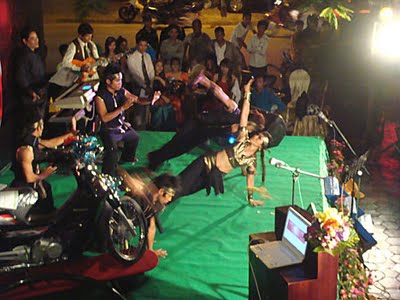 5 dancers on a stage as small as this, is no easy feat to perfrom. They had to share it with a motorbike and the musicians.
5 dancers on a stage as small as this, is no easy feat to perfrom. They had to share it with a motorbike and the musicians.Labels: Belle
Labels: Belle, Mekong Orchards
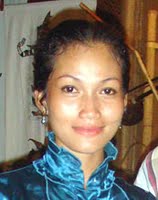 The Khmer Arts Ensemble will hold an open rehearsal at their Takhmau headquarters tomorrow morning from 9am and will perform their work, Ream Eyso & Moni Mekhala at 7pm on Friday 11 September. Next month, also at Chenla, will be the contemporary dance event, Dansez-Roam, on 16, 17, 24 & 25 October. One face who will not be taking part is Chumvan Sodhachivy, or Belle (pictured) as she's better known to all, who spent the first six months of this year as the associate artist with the French Cultural Center and has just returned from a workshop in Taiwan. In a couple of weeks, she will be off to Europe for two months, working with choreographer Emmanuelle Phuon in Brussels and then completing an internship at the unique National Choreographic Center in Montpellier, France. She simply never stops working.
The Khmer Arts Ensemble will hold an open rehearsal at their Takhmau headquarters tomorrow morning from 9am and will perform their work, Ream Eyso & Moni Mekhala at 7pm on Friday 11 September. Next month, also at Chenla, will be the contemporary dance event, Dansez-Roam, on 16, 17, 24 & 25 October. One face who will not be taking part is Chumvan Sodhachivy, or Belle (pictured) as she's better known to all, who spent the first six months of this year as the associate artist with the French Cultural Center and has just returned from a workshop in Taiwan. In a couple of weeks, she will be off to Europe for two months, working with choreographer Emmanuelle Phuon in Brussels and then completing an internship at the unique National Choreographic Center in Montpellier, France. She simply never stops working.Labels: Belle, Lakhaon Festival
Labels: Belle, We're Gonna Go Dancing
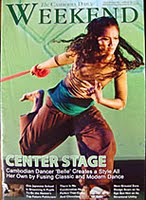 Also coming up soon will be a new performance by the star of Cambodia's contemporary dance scene, Belle (as seen on the cover of The Cambodia Daily), who will join with Japanese artists to present a performance at the Parkway Center, 2nd floor, at 6.30pm on Tuesday 1st September. Belle has just returned from Taiwan and will soon take off for a two-month sojourn to Europe to further expand her repertoire.
Also coming up soon will be a new performance by the star of Cambodia's contemporary dance scene, Belle (as seen on the cover of The Cambodia Daily), who will join with Japanese artists to present a performance at the Parkway Center, 2nd floor, at 6.30pm on Tuesday 1st September. Belle has just returned from Taiwan and will soon take off for a two-month sojourn to Europe to further expand her repertoire.Labels: Belle, Khmer Arts Ensemble, Khmer Mekong Films, Vanished
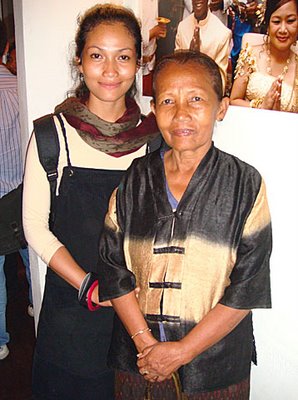
Labels: Belle, David P Chandler
Labels: Belle, Look At Us Now, Sovanna Phum
 Busy boy as I am, I met Ravynn Karet-Coxen and Nick Wood for breakfast at Java to find out more about the Nginn Karet Foundation that is providing help to 14 villages in the Banteay Srei district of Siem Reap with health, education, agriculture and a dance school, which was recently named the NKFC Conservatoire Preah Ream Bopha Devi. Over 2,500 families are getting direct help from the foundation, though its not all one way help, as the families have to meet criteria to earn the help on offer. The dance school has nearly 150 students and they have recently performed for the King in Phnom Penh and then held a sacred ceremony at the temple of Banteay Srei in honour of the King's birthday. You can read more about the Nginn Karet Foundation here and here. Brit Nick Wood is the founder of Navigator Films and he's been living in Cambodia for the last eight years, working on various film and television projects including the popular At The Factory Gates which has been a regular on Khmer tv about the plight of garment workers. Nick's current project is much further from home, in Columbia to be precise and focuses on the severe landmine problem that country is facing.
Busy boy as I am, I met Ravynn Karet-Coxen and Nick Wood for breakfast at Java to find out more about the Nginn Karet Foundation that is providing help to 14 villages in the Banteay Srei district of Siem Reap with health, education, agriculture and a dance school, which was recently named the NKFC Conservatoire Preah Ream Bopha Devi. Over 2,500 families are getting direct help from the foundation, though its not all one way help, as the families have to meet criteria to earn the help on offer. The dance school has nearly 150 students and they have recently performed for the King in Phnom Penh and then held a sacred ceremony at the temple of Banteay Srei in honour of the King's birthday. You can read more about the Nginn Karet Foundation here and here. Brit Nick Wood is the founder of Navigator Films and he's been living in Cambodia for the last eight years, working on various film and television projects including the popular At The Factory Gates which has been a regular on Khmer tv about the plight of garment workers. Nick's current project is much further from home, in Columbia to be precise and focuses on the severe landmine problem that country is facing. Later this afternoon, a surprise visitor to my office was the young woman who seems to single-handedly carry the expectation of a nation on her graceful shoulders as far as the future of contemporary dance is concerned. Belle (Chumvan Sodhachivy) is a lady in demand, her name is rarely out of the newspapers and that's quite a heavy burden on a young Khmer woman in my view. For her part, Belle (pictured right) is focused on her art, she felt from an early age of her dance training that she wanted to express herself and to find new ways to do that outside the strict confines of traditional classical dance. With the support of her mother she has done exactly that, and is leading from the front as contemporary dance begins to take a foothold amongst the artistic community and audience in Phnom Penh. Working with the French Cultural Center for the last six months has broadened her horizons even further and she won't stop there. She is open to any artform, recently working with hip-hop artists for example, has plans to travel abroad to seek more influences and to incorporate those into her choreography in the future. Belle is on a mission to take dance to another level and with an incredible track record so far, I'll bet she will definitely succeed.
Later this afternoon, a surprise visitor to my office was the young woman who seems to single-handedly carry the expectation of a nation on her graceful shoulders as far as the future of contemporary dance is concerned. Belle (Chumvan Sodhachivy) is a lady in demand, her name is rarely out of the newspapers and that's quite a heavy burden on a young Khmer woman in my view. For her part, Belle (pictured right) is focused on her art, she felt from an early age of her dance training that she wanted to express herself and to find new ways to do that outside the strict confines of traditional classical dance. With the support of her mother she has done exactly that, and is leading from the front as contemporary dance begins to take a foothold amongst the artistic community and audience in Phnom Penh. Working with the French Cultural Center for the last six months has broadened her horizons even further and she won't stop there. She is open to any artform, recently working with hip-hop artists for example, has plans to travel abroad to seek more influences and to incorporate those into her choreography in the future. Belle is on a mission to take dance to another level and with an incredible track record so far, I'll bet she will definitely succeed.Labels: Belle, Nginn Karet Foundation
Labels: Belle, Dansez Roam